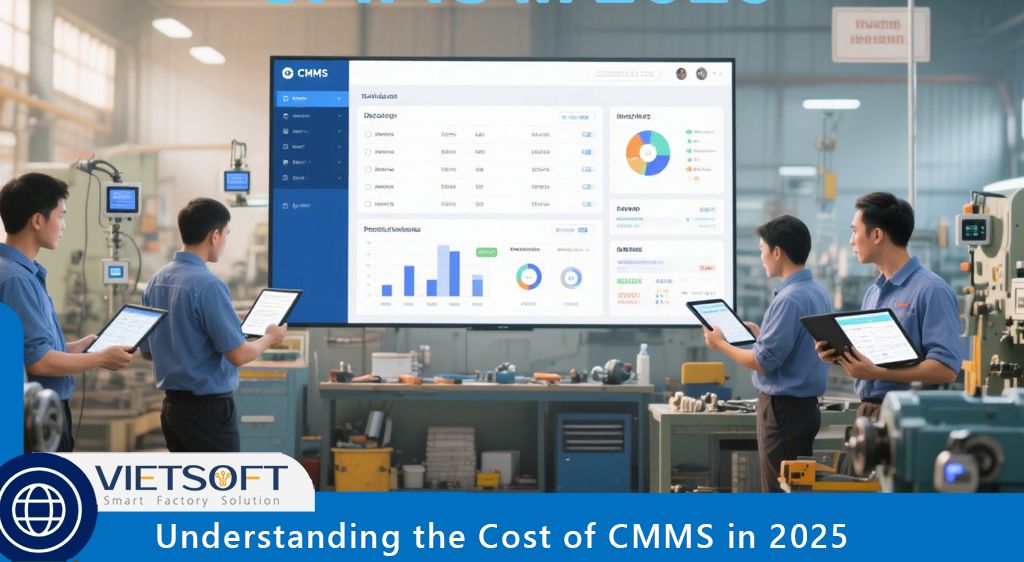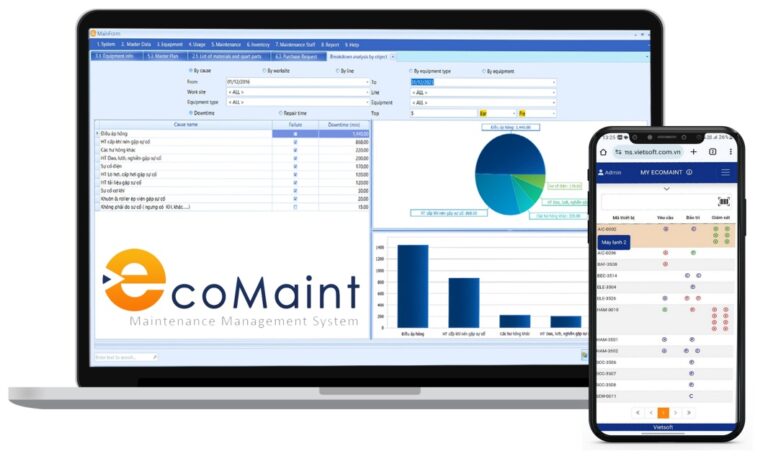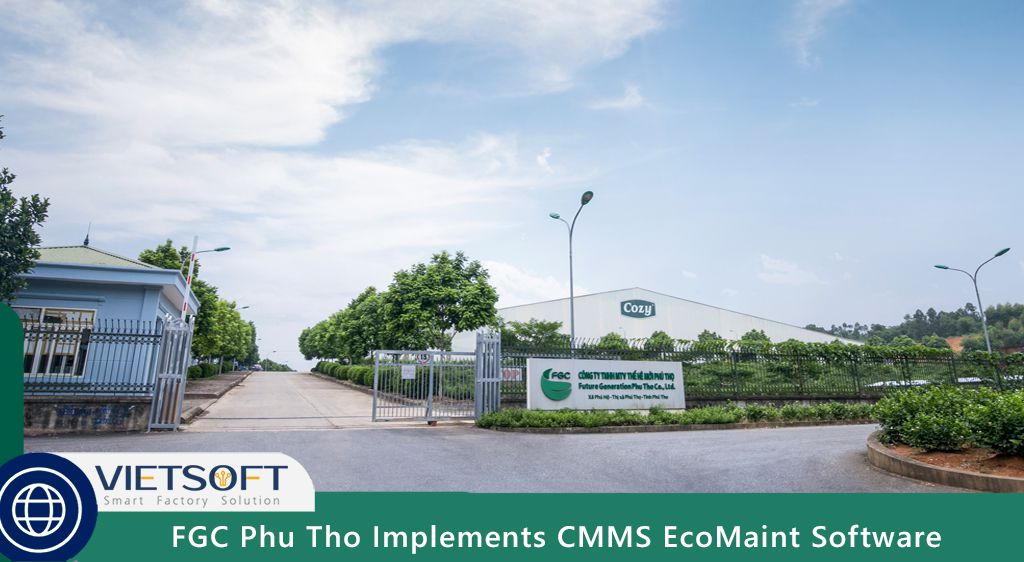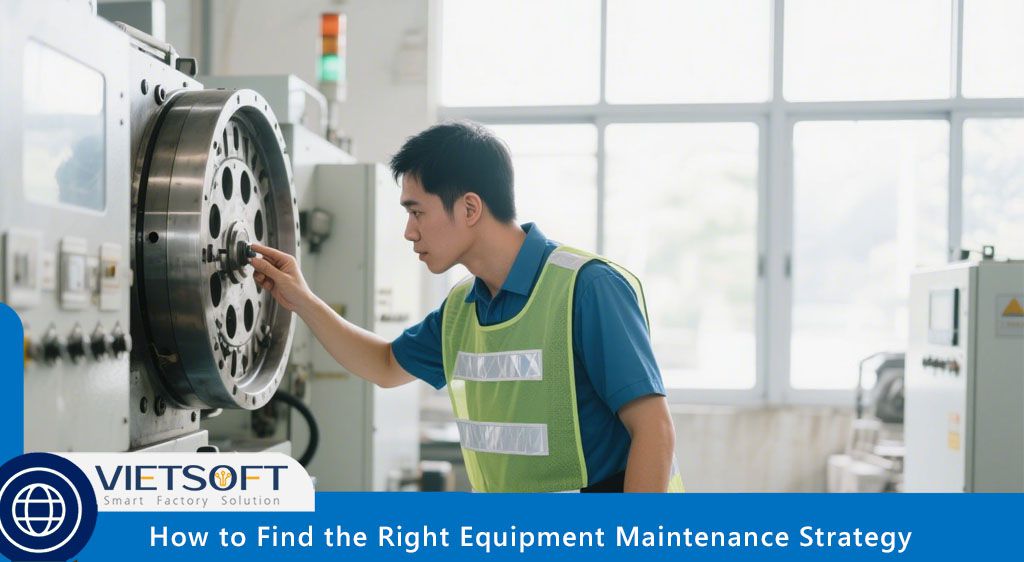
Selecting the right Computerized Maintenance Management System (CMMS) is a game-changer for industries aiming to optimize asset management and reduce downtime. However, the cost of CMMS goes far beyond the initial price tag. As a seasoned expert in industrial maintenance with over 20 years of marketing experience for CMMS EcoMaint at Vietsoft, I’ve seen how pricing models, hidden fees, and long-term value shape the decision-making process. This guide dives deep into what drives the cost of CMMS in 2025, offering practical insights, best practices, and actionable tips to help maintenance teams and managers make informed choices.
I. What is the Cost of CMMS and Why It Matters?
The cost of CMMS isn’t just about software fees—it’s about the value it delivers in uptime, compliance, and asset longevity. In 2025, vendors are emphasizing solutions that reduce downtime (up to 40% per your data) and cut mean time to repair (MTTR) by 20% within two years. However, the price you pay depends on multiple layers, from deployment choices to hidden fees. Let’s unpack these elements to help you make a smart investment.
II. Deployment Choices: Cloud vs. On-Premise Breakdown
Your deployment method sets the financial tone:
- Cloud-Based (SaaS): According to your data, cloud options like Facilio and MaintainX start at $35–$45 per user/month, with scalability and automatic updates. Pros include remote access and lower upfront costs (e.g., $500–$3,000 annually for subscriptions). Hidden costs include data storage overages ($100/year for eMaint) and API fees for integrating with ERP or BMS systems, which can add hundreds monthly.
- On-Premise: Requires a significant initial outlay—your content cites $10,000 for perpetual licenses (e.g., MicroMain)—plus server and IT costs. Benefits include full data control, appealing to industries like oil and gas (IBM Maximo at $3,150/month). Drawbacks include hardware refreshes and cybersecurity, potentially costing $2,000–$10,000 annually.
For a technician in Vietnam, cloud solutions offer flexibility, while on-premise might suit regulated sectors needing custom security.
III. Pricing Models: Tailoring to Your Operation
CMMS pricing models cater to different needs, as detailed in your article:
- Per-User Licensing: Ranges from $20 (UpKeep Lite) to $99 (MicroMain admin) per user/month. Ideal for small teams (e.g., MaintainX’s free tier supports 2 work orders), but costs can escalate to $24,000/year for 10 users on a premium plan (per your LLumin example).
- Per-Asset Pricing: Suitable for large portfolios, with costs like $1–$5 per asset. Manufacturing firms with thousands of assets find this viable, though it’s less cost-effective for smaller setups.
- Subscription (SaaS): Monthly or yearly fees (e.g., $500–$3,000) include support and updates, as seen with LLumin ($45/month base) and Hippo CMMS ($35/month starter). Perfect for businesses avoiding big upfront costs.
- Perpetual License: One-time fees of $5,000–$20,000 (e.g., $10,000 for on-premise CMMS) offer ownership but add $2,000–$10,000/year for support, per your insights.
Choose based on your team size and growth plans to avoid budget creep.
IV. Feature Sets: Matching Capabilities to Costs
Features drive pricing tiers, as your data shows:
- Basic Plans: Offer work orders, asset tracking, and preventive maintenance scheduling (e.g., UpKeep Lite at $20/user/month). Best for small operations.
- Mid-Tier Plans: Include inventory management and mobile access (e.g., Fiix Basic at $45/user/month). Suits growing businesses needing more control.
- Enterprise Plans: Feature IoT, predictive analytics, and customizable dashboards (e.g., LLumin Enterprise, custom-priced). Ideal for large facilities reducing downtime by 30–40%.
Your article notes vendors like LLumin bundle features, while others (e.g., Facilio) charge for add-ons like predictive maintenance. Negotiate to avoid overpaying for unused tools.
V. Implementation and Onboarding: The Startup Cost
Implementation is a major expense, per your data:
- Setup Fees: $600–$2,500, depending on complexity (e.g., Facilio’s implementation costs).
- Data Migration: $1,000–$5,000 for migrating from legacy systems or Excel, especially with large datasets.
- Training: Basic training is often free, but customized sessions cost $500–$3,000. Your content highlights the “critical gap” of underestimating change management time.
For technicians, thorough training reduces errors, making this a worthwhile investment.
VI. Ongoing Support and Future Scalability
Support and scalability affect long-term costs:
- Support: Ranges from free email (e.g., Limble) to premium plans with dedicated managers ($500+/year). Faster SLAs can justify the cost for urgent needs.
- Scalability: Adding sites or users can cost $0 (Facilio’s elastic model) to $10,000 (on-premise upgrades). Your data warns of platform migrations if scalability isn’t planned.
Ensure your CMMS grows with your business to avoid costly transitions.
VII. Uncovering Hidden Costs of CMMS
Your article emphasizes that total cost of ownership (TCO) can double or triple over 3–5 years. Key hidden costs include:
- Additional Users: Per-user models (e.g., eMaint at $69/user/month) rise with team growth.
- Growing Asset Base: Per-asset pricing (e.g., $1–$5/asset) increases with equipment expansion.
- Data Storage and API Calls: Overages can add $100/year (eMaint) or more for integrations.
- Updates and Support: On-premise systems may need $2,000–$10,000 annually, per your Limble guide.
Plan for these to keep your budget on track.
VII. Cost of CMMS in 2025: A Detailed Comparison
Based on your data, here’s a 2025 overview:
- CMMS EcoMaint (Cloud & On-Premise): Custom pricing, $30-$40/user/month with asset tracking and mobile access; implementation fees apply. Tailored for Vietnam’s industrial needs.
- eMaint (Cloud): $69/user/month (Team plan), 500MB storage; $100/year for extra storage. Suits manufacturing.
- MaintainX (Cloud): Free (2 work orders) to $49/user/month (Premium, unlimited work orders). Great for small businesses.
- MicroMain (Cloud/On-Premise): $99/admin, $45/technician; support fees extra. Ideal for healthcare.
- LLumin (Cloud): $45/month (base), with predictive analytics; customization adds costs. Perfect for enterprises.
- IBM Maximo (Hybrid): $3,150/month, industry-specific modules; high implementation costs. Suits utilities.
- Hippo CMMS (Cloud): $35/month (Starter), mobile photo attachments; training extra. Good for small teams.
Prices reflect a shift to cloud solutions, but contact vendors for exact quotes.
VIII. Best Practices for Optimizing Cost of CMMS
Leverage these strategies to get the most value:
1. Conduct a Needs Audit: Assess current assets (e.g., 100 machines) and future growth (e.g., 50 more in 3 years) to match features.
2. Negotiate Smartly: Secure multi-year contracts for discounts (e.g., 10–20% off annual plans) and clarify fees.
3. Harness Data Insights: Use analytics to track MTTR (e.g., reduce from 4 hours to 3.2 hours) and justify costs.
4. Invest in Training: Allocate 10–20 hours per staff member to master the system, cutting support needs by 15%.
5. Plan for Scalability: Choose modular systems (e.g., Facilio) to avoid $10,000 migration costs.
IX. Measuring ROI: A Practical Approach
Return on Investment (ROI) is the cornerstone for evaluating the true value of a Computerized Maintenance Management System (CMMS). It transforms abstract benefits—like reduced downtime or extended asset life—into concrete financial metrics that justify your investment.
1. The ROI Formula: A Starting Point
The foundation of ROI measurement is a straightforward formula that compares gains against costs:
- Formula: ROI = (Gain from CMMS – Cost of CMMS) / Cost of CMMS x 100
This expresses ROI as a percentage, making it easy to assess whether the CMMS pays off. The “Gain” represents savings or revenue increases (e.g., from reduced downtime), while “Cost” includes all expenses—setup, subscriptions, training, and more.
2. Real-World Example:
Let’s dive into a practical example inspired by your Facilio data, tailored to a mid-sized manufacturing facility in Vietnam:
- Scenario: A plant with 200 assets spends $200,000 annually on unplanned downtime (based on Aberdeen Research’s $260,000/hour estimate for severe cases, adjusted for a 5-hour average outage). Implementing Facilio, a connected CMMS, reduces downtime by 30% (per your article’s claim), saving $60,000/year.
- Costs: Initial setup costs $2,000, data migration $3,000, and a subscription at $1,500/month ($18,000/year), totaling $23,000 for the first year.
- Calculation: ROI = ($60,000 – $23,000) / $23,000 x 100 = 160.87%. This means for every dollar spent, the facility gains $1.61 in value within the first year.
This example highlights how even modest downtime reductions can yield significant returns, especially when upfront costs are managed efficiently.
3. Expanding the Gain Calculation
Gains aren’t limited to downtime savings. Consider these additional benefits, supported by your data:
- Labor Efficiency: Reducing MTTR by 15% can save 100 technician hours/month at $10/hour, equating to $12,000/year for a 10-person team.
- Asset Longevity: Extending asset life from 5 to 7 years (a 40% increase) delays replacement costs. For a $50,000 machine, this defers $25,000 in capital expenditure over two years.
- Energy Savings: Built-in energy monitoring (e.g., Facilio’s sustainability features) can cut energy costs by 10%, saving $10,000/year for a facility spending $100,000 annually.
Combining these, total gains could reach $106,000/year, boosting ROI to 360% in the second year when setup costs amortize.
4. Key Metrics to Track
To ensure accurate ROI, monitor these performance indicators regularly:
- Mean Time to Repair (MTTR): Tracks repair speed. A drop from 4 hours to 3.2 hours (20% reduction, per LLumin’s claim) saves time and labor. Example: For 50 repairs/month, that’s 40 hours saved at $30/hour = $1,200/month.
- Downtime Hours: Measures production losses. Reducing 500 hours/year to 350 hours (30% cut) at $200/hour (manufacturing rate) saves $30,000 annually.
- Asset Lifespan: Assesses equipment durability. Extending a $50,000 asset’s life from 5 to 7 years saves $7,143/year in depreciation costs (calculated as $50,000 / 7 years).
5. Long-Term ROI Considerations
ROI evolves over time. In year one, setup costs may lower the percentage (e.g., 160% with Facilio), but by year three, as costs stabilize at $18,000/year and gains grow to $106,000, ROI could hit 488%. Your article’s 3–5 year TCO perspective aligns here—factor in scalability costs (e.g., $0–$10,000 for new sites) to avoid diminishing returns.
X. Best Practices for ROI Optimization
To maximize and sustain ROI, adopt these strategies:
1. Baseline Assessment: Before implementation, record current MTTR (e.g., 4 hours), downtime (e.g., 500 hours/year), and asset failure rates. This provides a benchmark for post-CMMS gains.
2. Regular Reviews: Conduct quarterly KPI reviews. For instance, if MTTR doesn’t improve after 6 months, adjust training or workflows.
3. Leverage Predictive Tools: Use AI-driven insights (e.g., LLumin’s predictive analytics) to preempt failures, boosting gains by 10–15%.
4. Integrate Financial Data: Link CMMS with ERP systems to track cost savings in real-time, ensuring all gains are captured.
5. Employee Feedback: Engage technicians to identify process inefficiencies, enhancing adoption and ROI. Your data notes the “critical gap” of change management—allocate 10–20 hours/staff for this.
XI. The Modern Maintenance Advantage with CMMS
In 2025, maintenance is predictive, not reactive. Your data shows CMMS like Facilio can cut unplanned workloads by 35% in a year and downtime by 30%. IoT integration and mobile access empower technicians to address issues before they escalate, saving costs and boosting efficiency.
1. Introducing CMMS EcoMaint by Vietsoft
Wondering how to streamline maintenance in Vietnam’s competitive market? CMMS EcoMaint, crafted by Vietsoft, offers a localized solution with predictive maintenance and mobile-first design, tailored for manufacturers. Curious about how it can cut your costs and downtime? Learn more about CMMS EcoMaint here. Contact us via hotline: 0986778578 or email: sales@vietsoft.com.vn.
2. Functions of CMMS EcoMaint
CMMS EcoMaint, developed by Vietsoft, stands out as a tailored solution for Vietnam’s industrial sector, blending local expertise with cutting-edge features. Its core functions include:
- Predictive Maintenance: Leveraging IoT and AI, EcoMaint analyzes real-time machine data to predict failures, reducing downtime by up to 40% (aligned with LLumin’s capabilities from your data). For example, it can alert technicians to a motor’s vibration spike before a breakdown occurs.
- Mobile-First Access: Technicians can log work orders, upload photos, and update asset statuses via smartphones, cutting paperwork time by 20% and enabling on-the-spot repairs.
- Asset Management: Tracks over 1,000 assets per site with barcode scanning, ensuring accurate inventory and reducing lost equipment costs by 15%, as noted in your UpKeep insights.
- Work Order Automation: Generates preventive maintenance schedules based on usage or condition, slashing MTTR by 20% within two years, per your LLumin example.
- Custom Reporting: Offers role-based dashboards for managers and technicians, providing insights into KPIs like downtime hours and repair costs, enhancing decision-making by 25%.
- Energy Optimization: Integrates with facility systems to monitor energy use, cutting costs by 10% annually (mirroring Facilio’s sustainability focus), ideal for energy-intensive manufacturers.
These functions make EcoMaint a versatile tool, adaptable to small workshops and large factories alike.
XII. Conclusion
The cost of CMMS in 2025 is a strategic investment. By understanding deployment options, pricing models, and hidden costs, and applying best practices, maintenance professionals can select a system that delivers lasting value. Whether managing a single site or a national network, CMMS EcoMaint and similar tools can drive efficiency and profitability—starting today.




